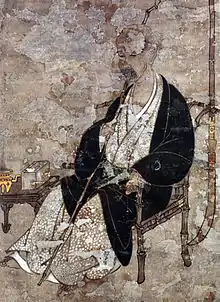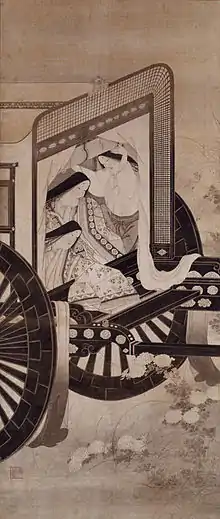Iwasa Matabei
Iwasa Matabei (Japanese: 岩佐 又兵衛, romanized: Iwasa Matabē; original name Araki Katsumochi [1] 1578 – July 20, 1650) was a Japanese artist of the early Tokugawa period (1603–1867),[2] who specialized in genre scenes of historical events and illustrations of classical Chinese and Japanese literature, as well as portraits. He was the son of Araki Murashige, a prominent daimyō of the Sengoku period who had been made to commit suicide, leaving Matabei to be raised with his mother's family name, Iwasa.[3][4]

Matabei's work was noted for its distinctive figures, with large heads and delicately drawn features, and he was effective both in colour and monochrome ink-wash painting, using an individual brush technique combining Tosa and Kanō elements.[5] Although trained by Kanō Naizen of the Kanō school, he was more influenced by the traditions of the Tosa school, and signed a late series of portraits of the Thirty-six Poetry Immortals (1640) commissioned by the shōgun Tokugawa Iemitsu for a temple as "the artist Matabei of the later current from Tosa Mitsunobu".[6] His work is often regarded as a major influence on the developing ukiyo-e school of painting, which is possibly because of confusion with an ukiyo-e artist character with the same name (Ōtsu no Matabei) in a play by Chikamatsu. Also, he used often to be attributed as the painter of a famous early ukiyo-e screen known as the Hikone screen, but this is now considered incorrect.[7] In fact his "patrons ... were so high in the social hierarchy that it is hard to believe that Matabei could have created the Ukiyo-e tradition", and he is better regarded as a "great independent artist of the Tosa tradition".[8]
His son Katsushige (d. 1673) was also a painter, known for dancing figures in a style like that of his father.[9]

17th century. Hanging scroll, ink and colour on paper.
Notes
- Encyclopædia Britannica, "Iwasa Matabei"
- Encyclopædia Britannica, "Iwasa Matabei"
- Paine, 249–250
- Encyclopædia Britannica, "Iwasa Matabei"
- Paine, 250
- Paine, 250
- Paine, 247–248; Image of the Hikone screen
- Paine, 249–250, 250 quoted
- Paine, 250
References
- Encyclopædia Britannica, "Iwasa Matabei"
- Paine, Robert Treat, in: Paine, R. T. & Soper A, "The Art and Architecture of Japan", Pelican History of Art, 3rd ed 1981, Penguin (now Yale History of Art), ISBN 0140561080
External links
- Bridge of dreams: the Mary Griggs Burke collection of Japanese art, a catalog from The Metropolitan Museum of Art Libraries (fully available online as PDF), which contains material on Iwasa Matabei (see index)
- Personal history of Iwasa Matabei - Jyuluck-Do Corporation
| Wikimedia Commons has media related to Iwasa Matabei. |
